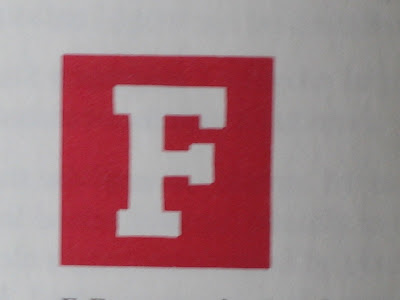 Georges Rouault, French. Born 1871. Grimacing Man from Flowers of Evil. Aquatint.
Georges Rouault, French. Born 1871. Grimacing Man from Flowers of Evil. Aquatint. 
The top narrow rectangle is an enlarged cross-section showing particles of resin on a plate surface.
1. Stopped out* before biting
2. One-minute bite - then stopped out.
3. 4 minute bite- then stopped out.
4. 16 minute bite, then stopped out.
Intaglio process. A tonal medium which permits 'grainlike' values in the print ranging from silvery grey to intense black. A porous ground of resin or other substances in applied to the plate, heated, then etched a number of times to produce the required values. (Jules Heller)
* Stopping out: Preventing certain lines or areas of a plate from biting, by brushing on an acid-proof material.



 Daumier (1808-79). French caricaturist, painter and sculptor. During his lifetime he was known chiefly as a political and social satirist, but since his death he has been increasingly recognized as a painter. In 1830, after learning the still fairly new process of lithography, he began to contribute political cartoons to the newly launched anti-monarchist weekly, La Caricature. It's said he produced more than 4,000 lithographs, wishing at the time that the one he had just made could be his last. His paintings were probably done for the most part fairly late in his career. As a caricaturist Daumier stands above all others of the 19th century. The essence of his satire lay in his power to interpret mental states in terms of physical absurdity, but in his directness of vision and lack of sentimentality he has affinities with the realism of Courbet. Although he never mad a commercial success of his art, he was appreciated by the discriminating, his friends and admirers including Baudelaire, Degas, Delacroix, and Forain. In his final years he was almost blind and was saved from destitution by Corot. (Ian Chilvers)
Daumier (1808-79). French caricaturist, painter and sculptor. During his lifetime he was known chiefly as a political and social satirist, but since his death he has been increasingly recognized as a painter. In 1830, after learning the still fairly new process of lithography, he began to contribute political cartoons to the newly launched anti-monarchist weekly, La Caricature. It's said he produced more than 4,000 lithographs, wishing at the time that the one he had just made could be his last. His paintings were probably done for the most part fairly late in his career. As a caricaturist Daumier stands above all others of the 19th century. The essence of his satire lay in his power to interpret mental states in terms of physical absurdity, but in his directness of vision and lack of sentimentality he has affinities with the realism of Courbet. Although he never mad a commercial success of his art, he was appreciated by the discriminating, his friends and admirers including Baudelaire, Degas, Delacroix, and Forain. In his final years he was almost blind and was saved from destitution by Corot. (Ian Chilvers)
















































